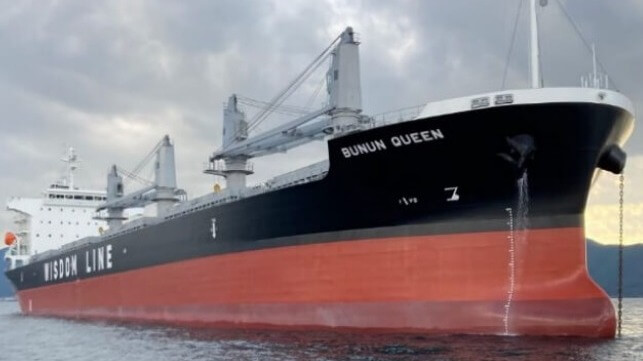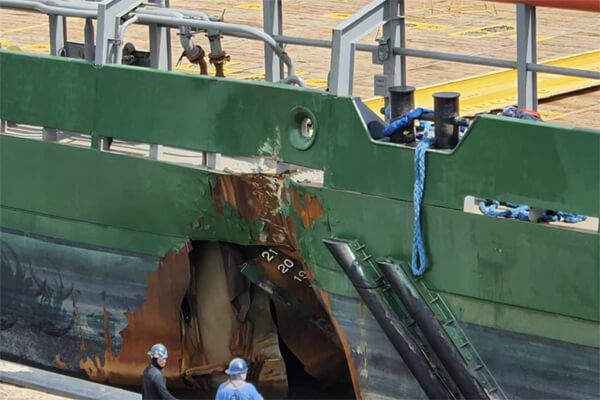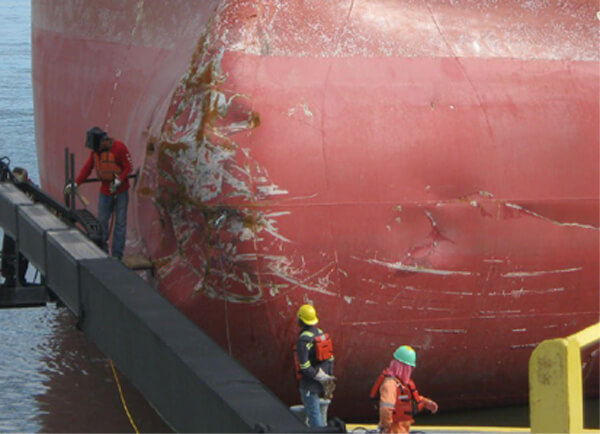NTSB: Cell Phone and Distracted Officers Caused Bulker-OSV Collision

The use of a personal cell phone by an officer on watch is being cited by the National Transportation Safety Board as the probable cause of a vessel collision that resulted in $12.3 million in damages and endangered the lives of 38 crewmembers aboard a bulk carrier and offshore supply vessel in the Gulf of Mexico. In a report released today, the safety board faults both vessels for not maintaining a proper lookout while traveling in a busy sea lane and not using the navigation resources available to help safeguard their operations.
“Nonoperational use of cell phones should never interfere with the primary task of a watchstander or a bridge team member to maintain a proper lookout. It is important for personnel to follow established protocols regarding cell phone use,” the NTSB writes in its report. They further highlight that both vessels only had a single person on the bridge leading up to the collision further faulting the master of the OSV for not following his company’s watchkeeping policies.
The collision occurred on July 23, 2022, approximately 66 miles south of Port Fourchon, Louisiana. The weather was not an issue with the report saying there was good visibility, daylight, and fair-weather conditions. They further note that each vessel’s automatic radar and plotting aid displays and AIS receivers were able to detect the vessels but that no alarms were set and with the officers on the bridge performing personal non-navigational tasks they were not checking the displays.

OSV received a significant penetration causing flooding and nearly $12 million in damages (USCG)
The Bunun Queen, a 590-foot, 37,300 dwt bulk carrier operated by Widom Marine International, departed Houston mid-day on July 22. The vessel was traveling in ballast bound for New Orleans. Before the accident, the vessel was on autopilot with a speed of 14.8 knots. There were 20 crew members aboard.
The second vessel was the Thunder, a 252-foot offshore supply vessel operated by Jackson Offshore Operations. The OSV had departed an offshore oil platform approximately 130 miles south of the port and was returning with a crew of 18 as well as cargo equipment and parts on its main deck. It was also on autopilot traveling at 10 knots before the accident.
The NTSB report reconstructs the actions before the accident reporting that the master was on the bridge of the OSV. He had sent the second mate and a mate-in-training to perform other tasks saying he would take the watch. While on the bulker, the second officer was on the bridge but the vessel’s AB had also left the bridge leaving the second officer without a dedicated lookout.
The master of the OSV later admitted to the NTSB that he had made a personal call using his cell phone, which he said lasted about one minute. Then he began using dictation to send personal text messages. At the same time, the second officer on the bridge of the bulker had begun printing updates for electronic navigation charts and digital publications. Later replaying the recording from each vessel’s VDR, the NTSB reports hearing “a machine” on the bridge of the bulker and the sounds of a “commercial (advertisement)” on the recording from the OSV.
The second mate aboard the OSV and an AB both saw the bulker approaching and sought to alert the master, who responded by disengaging autopilot, increasing the throttles, and turning to port “to minimize damage to the vessel.” Records show the bulker was still on autopilot.

Damage to the bulbous bow of the Bunun Queen (USCG)
The bulbous bow of the Bunun Queen struck the port side of the Thunder. The port side propulsion room of the OSV was penetrated and started to flood. The Thunder began to list to port and trim by the stern. The vessel lost propulsion but the chief engineer was able to maintain the electrical generators to power the ship. Eleven of the 18 crew were evacuated to another vessel in the area and the Thunder was towed to Port Fourchon.
The report concludes the penetration above and below the waterline of the Thunder caused its port propulsion room, port cargo tank, and port ballast tank to flood with repair costs of $11.6 million. The Bunun Queen suffered $680,000 in damages, including multiple dents and a crack in its bulbous bow, and a hull fracture in its shell plating.
The NTSB again cautions on the use of personal electronic devices saying they are distracting and companies should have policies against their use. Further, it is important for personnel to follow established protocols regarding cell phone use and watch policies.
